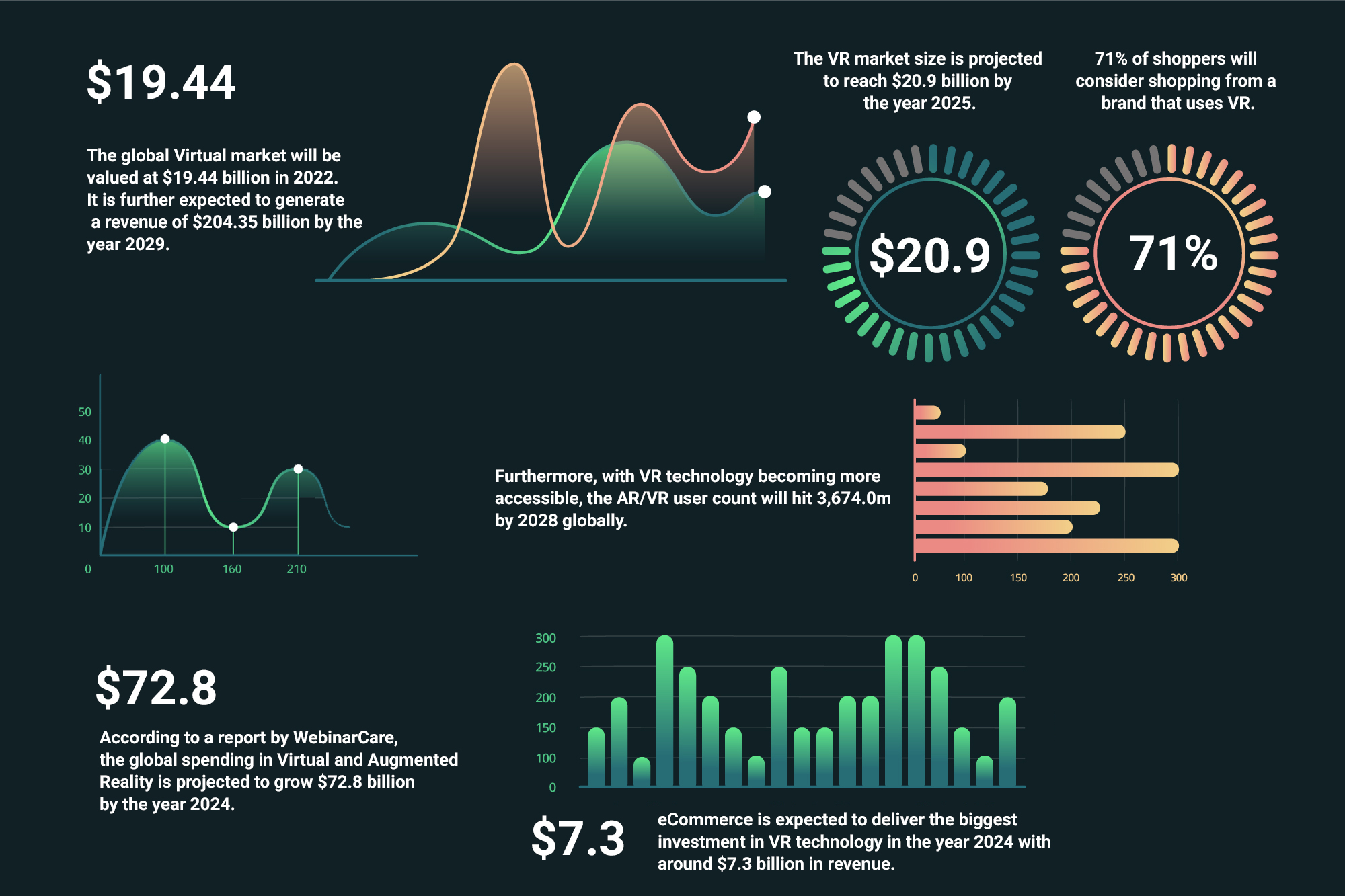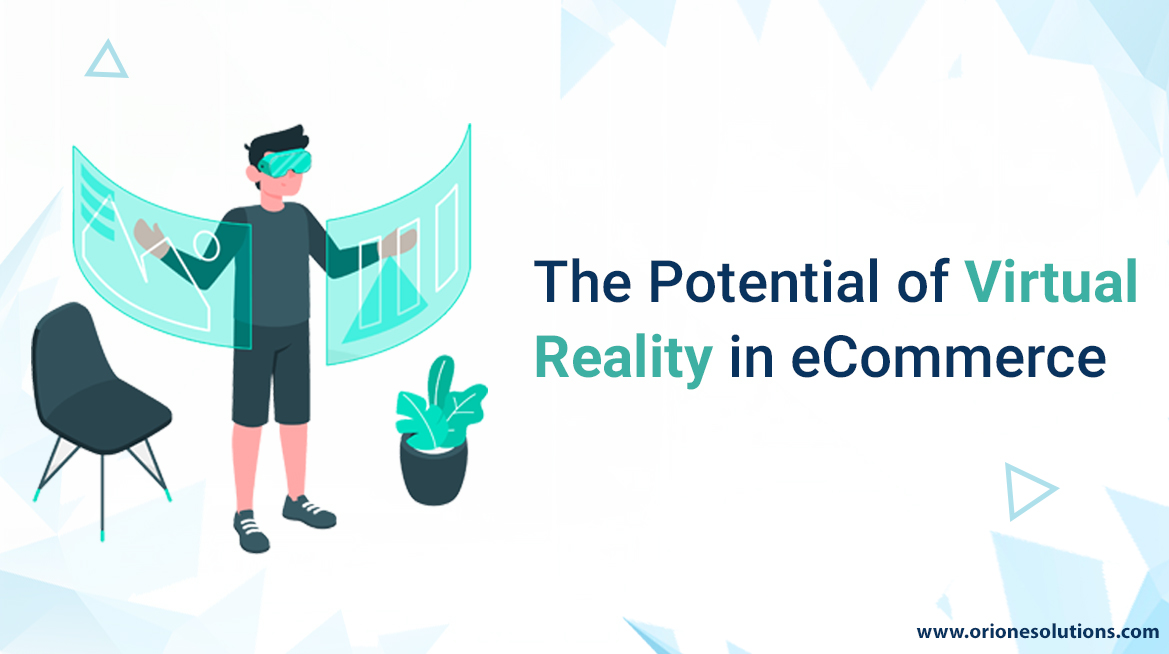For every eCommerce business merchant, building a website that provides customers the convenience of shopping anywhere, anytime is one essential thing to consider. Besides, if the business is purely online, the hassles associated with brick-and-mortar stores like leasing, permits, and maintenance vanishes.
However, shoppers these days expect transparency when shopping online. Also, the growing 3D shopping with engaging and realistic shopping experiences has transformed customers’ shopping behaviors, heightening the challenges for eCommerce businesses.
Here, entrepreneurs looking to step into the eCommerce world must leverage technologies like VR for customer satisfaction. It lets shoppers get detailed information about products in Virtual Reality, helping them make more informed and accurate decisions. Thus, benefiting both customers and businesses alike.
In this write-up, we will walk you through the growth statistics of Virtual Reality, and benefits of Virtual Reality in eCommerce landscape, and a few examples of popular players already benefiting from this technology.
Growth Dynamics and Statistics of Virtual Reality

How Adopting Virtual Reality Can Benefit Your eCommerce Business
The business benefits of integrating Virtual Reality in eCommerce depend on the kind of experience you wish to deliver. Usually, it helps improve customer satisfaction, sales, and overall customer experience.
Below are some advantages explained.
Virtual Try-Ons
Virtual try-ons enable customers to try and shop for whatever fits and suits them. Be it sunglasses, spectacles, jackets, shoes, or accessories, VR enables simple trying and buying convenience.
There are no hassles of trial rooms as with VR, customers can see how the clothes and accessories will look on different body types, providing realistic try-on experiences.
Creates Innovative Shopping Experience
One key benefit of Virtual Reality in eCommerce is its capability of delivering immersive shopping experiences. Customers can easily engage with the products virtually, almost feeling like they are shopping offline, saving them time and fuel costs.
Also, this level of engagement helps build trust among customers, help them make more informed decisions, and encourage them to shop repeatedly.
Improved Customer Satisfaction and Engagement
Customers these days need to think more than just content to keep the customer engaged and static images are the key.
Moving product videos, images, and other possible customizations helps deliver immersive customer experiences and keeps them engaged. Here, Virtual Reality can help hit all these notes perfectly, enabling customers to make informed decisions.
Facilitates Product Customization
VR technology in eCommerce provides customers with the complete details of the products in the virtual settings, allows them to tweak their looks, and enables them to share their suggestions or requests for customizations.
For example, they can view one product in different models, colors, sizes, and so on, and create a suitable item by blending multiple choices and features. Also, the products that are not available in-store can be virtually viewed, delivering an immersive online experience.
Helps Strengthen Marketing Capabilities
Virtual Reality and Artificial Intelligence together provide access to customer insights and in-depth data analytics beneficial for marketing purposes. Utilizing this data, eCommerce businesses can run more targeted marketing campaigns.
For example, businesses can add interactive elements to the ad campaigns. Further, introducing virtual rewards, exclusive points, contests, and beyond can make marketing campaigns and shopping more engaging for customers and help brands build credibility.
Examples of a Few Popular eCommerce Players Leveraging Virtual Reality
The key advantages of VR technology are best suited to the eCommerce businesses dealing in products where size or aesthetics matter. Below are listed some popular players leveraging VR at its best.
Nike
Nike partnered with Roblox to create a virtual space, ‘Nikeland.’ It comprises Nike fields, buildings, and areas where players can virtually play multiple minigames. This virtual space also involves a showroom where players can try on virtual products like Nike Blazers with their avatars, buy NFTs, and much more.
Furthermore, the users can develop their games from scratch, providing them with more real-time and personalized experience.
IKEA
IKEA’s virtual reality app enables customers to preview how furniture will look in their room before buying and the precision rate defined is 98%. The application also includes a 3D room planner and virtual showroom, allowing them to experiment with multiple styles and layouts in their own space.
IKEA, leveraging VR technology, improves the shopper’s shopping experience and makes it more fun and engaging. Thus, ensuring increased customer satisfaction and conversions.
Sephora
Sephora offers an amazing try-on makeup experience to customers. They can utilize VR headsets to try on multiple makeup products like false lashes, lipstick, and more and see in real time how each product looks on their faces.
Also, customers can dive into digital beauty tutorials to learn and try on their faces to achieve certain looks. All this helps the shoppers make the right purchasing decisions.
Alibaba Buy+
It is another great example that has incorporated VR amazingly. Alibaba has introduced Alibaba Buy + using VR to enhance customer’s shopping experiences. It provides a virtual environment where customers can use VR headsets to see, touch, feel, and even try on the products.
Thus, providing a similar shopping experience to brick-and-mortar stores.
Final Thoughts
In this digital era, where omnichannel strategies are taking businesses forward, technologies like Virtual Reality seem ideal for delivering exemplary experiences, especially in the eCommerce landscape.
Experience the Future Today!
Connect with our experts for cutting-edge VR ecommerce app development solutions!
From increased customer engagement and satisfaction to reduced customer churn rates, this technology helps retailers transform the way customers shop online. Thus, opening up ample opportunities for businesses to establish a strong presence and a huge customer base.
Frequently Asked Questions
Q1. What do I need to build a Virtual Reality application for my eCommerce business?
Answer: When you know the goal of your eCommerce business, the next thing you need to do is consider the right technology you would want to integrate. Also, choose the right software development company to help you build the desired product, meeting your end goals.
Q2. How can VR be used in shopping?
Answer: Virtual Reality enables shoppers to try on clothes, makeup, and other products at their leisure. Customers need not leave their homes and visit the brick-and-mortar stores to make purchases. They can leverage 3D videos and images, zoom-in functionality, and various customization and filter options, ensuring the best possible interaction with the brand and shopping experience.
Q3. What are the disadvantages of Virtual Reality in eCommerce?
Answer: Virtual Reality is quite expensive. You need to spend hundreds of dollars on gadgets like VR headsets and additional equipment to maintain high performance. Also, VR can cause health ailments to many users such as headaches, motion sickness, or eye strain.
Q4. Which is the best VR development company?
Answer: If you are an eCommerce merchant thinking of giving Virtual Reality a try, make customer satisfaction your main motto. Besides, working with a specialized VR development company like Orion eSolutions, you can rest assured everything from building the software solution from scratch to adding top-notch features to existing systems is in the right hands. We can deliver solutions ready for market entry and sustainable business growth.









